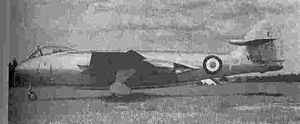
Armstrong Siddeley Snarler
Encyclopedia

Armstrong Siddeley
Armstrong Siddeley was a British engineering group that operated during the first half of the 20th century. It was formed in 1919 and is best known for the production of luxury motor cars and aircraft engines.-Siddeley Autocars:...
Snarler was a small rocket engine used for combined-power experiments with an early turbojet engine. It was the first British liquid-fuelled rocket engine to fly Unlike other rocket British projects that used hydrogen peroxide, Armstrong Siddeley's used liquid oxygen
Liquid oxygen
Liquid oxygen — abbreviated LOx, LOX or Lox in the aerospace, submarine and gas industries — is one of the physical forms of elemental oxygen.-Physical properties:...
. The rocket engine is described as having a dry weight of 215 lbf (956.4 N) thrust of 2000 lbf (8.9 kN) and a specific fuel consumption of 20 (lb/h)/lbf thrust. Work began in 1947 and the final configuration was first tested on 29 March 1950.
The prototype of the Hawker P.1040 Sea Hawk
Hawker Sea Hawk
The Hawker Sea Hawk was a British single-seat jet fighter of the Fleet Air Arm , the air branch of the Royal Navy , built by Hawker Aircraft and its sister company, Armstrong Whitworth Aircraft. Although its origins stemmed from earlier Hawker piston-engined fighters, the Sea Hawk became the...
, VP 401, had a Snarler rocket of 2,000 lbf thrust added in its tail. The Rolls-Royce Nene
Rolls-Royce Nene
|-See also:-References:NotesBibliography* Bridgman, L, Jane's fighting aircraft of World War II. Crescent. ISBN 0-517-67964-7-External links:* *...
turbojet, of 5,200 lbf thrust, had a split tailpipe which exhausted either side of the fuselage. The combination was termed the Hawker P.1072
Hawker P.1072
-See also:-References:* Hannah, Donald. Hawker FlyPast Reference Library. Stamford, Lincolnshire, UK: Key Publishing Ltd., 1982. ISBN 0-946219-01-X....
. This gave approximately 50% greater thrust, although at a fuel consumption of around 20×. It was first used in flight on 20 November 1950, by Hawker's test pilot
Test pilot
A test pilot is an aviator who flies new and modified aircraft in specific maneuvers, known as flight test techniques or FTTs, allowing the results to be measured and the design to be evaluated....
Trevor "Wimpy" Wade. Half a dozen flights were made using the rocket motor before a minor explosion damaged the aircraft. Although methanol was used in the P.1072, jet fuel could be used for the Snarler. It was decided that reheat was a more practical proposition for boosting jet thrust than rockets.
An unusual feature of the engine was that the turbopump was externally driven, by a drive from the gearbox of the P.1072's turbojet engine.

